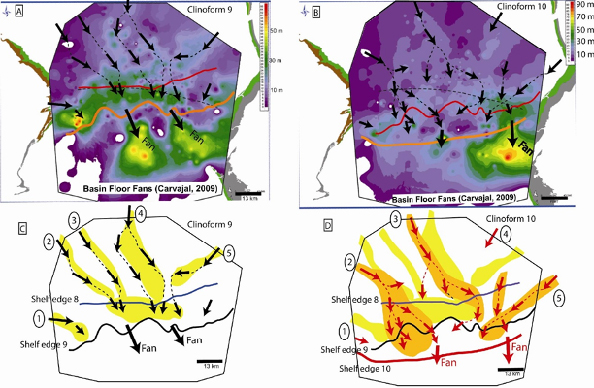|
DYNAMIC STRATIGRAPHY WORKGROUP |
|
People: Mariana I. Olariu, Cristian R. Carvajal, Ronald J. Steel, Cornel Olariu Research question(s): This study aims to describe the Lewis-Fox Hills shelf margin architecture over shorter time intervals (fifth-order cycles) in terms of the dominant processes and sediment partitioning into various depositional environments from shoreline to shelf-slope break with an emphasis on the deltaic complexes of the Fox Hills through a detail analysis of their dimensions, orientation and facies as they autogenically shifted during repeated cross-shelf transits. This study aims to describe the Lewis-Fox Hills shelf margin architecture over shorter time intervals (fifth-order cycles) in terms of the dominant processes and sediment partitioning into various depositional environments from shoreline to shelf-slope break with an emphasis on the deltaic complexes of the Fox Hills through a detail analysis of their dimensions, orientation and facies as they autogenically shifted during repeated cross-shelf transits. |
|
Process and Architectural Evolution during Deltaic Cross-Shelf Transits – Fox Hills Deltas, Washakie Basin, Wyoming |
|
Summary of work: The topset compartments of two Maastrichtian clinothem complexes (C9 and C10) are described using outcrop (eleven vertical stratigraphic successions) and subsurface data (about 1000 well-logs - mostly gamma-rays, but also spontaneous potential and conductivity logs). Correlation of closely spaced well logs allowed identifying the regressive transits of deltas (individual parasequences) based on which the shelf-edge trajectory was determined. The behavior of the trajectory over short-time scales (fifth-order cycles) describes aggradation/progadation pattern of individual deltaic complexes. Gamma-ray logs have been normalized (sand cut-off value 10-90) and used to build isopach maps for sandstone to delineate sand depositional environments and paleo-shoreline trends. Sand isopach maps of the topset deposits of clinoform 9 show that (1) there are coeval delta lobes suggesting multiple rivers, (2) delta complexes have a likely autogenic compensational stacking pattern, (3) wave-dominated deltas become more common closer to the shelf edge and (4) in general the deltas thicken towards the shelf edge. Sand isopach maps of the Clinoform 10 topsets indicate strongly river influence suggested by the rapid progradation of the delta complex on the inner-shelf. Evidence of lobe switching is suggested by multiple sand depocenters of the inner-shelf deltas. As the deltas reached the shelf edge, wave influence became more important. Mid- to outer- shelf deltaic complexes have a strike-elongate pattern suggesting wave dominance. The number and thickness of shelf-delta successions are greater for rising shelf-edge trajectories (C9) than for gently rising or flat trajectories (C10). Stable or lower rates of relative sea level rise generated less topset accumulation and favored basinward migration of the shelf margin of Clinoform 10. |
|
Comparison of the shelf deposcenter locations and sediment fairways between clinoform 9 and clinoform 10. A– Sand isopach for clinoform 9 with location of the sediment paths. B– Sand isopach for clinoform 10with location of the sediment paths. C– Routes from the inner shelf to the outer shelf for clinoform 9. D– Routes from the inner shelf to the outer shelf for clinoform 10. The round circles are river drainages that discharge on the shelf |

|
Publications and presentations:
Publications:
Conference/meeting presentations: Olariu M. I., Carvajal R. C., Steel J. R., Olariu C., 2010, Process and Architectural Evolution during Deltaic Cross-Shelf Transits – Fox Hills Deltas, Washakie Basin, Wyoming, AAPG Annual Meeting, New Orleans |